 Loading...
Loading...
It is Time to Speak up for Alaska’s National Wildlife Refuges
 Loading...
Loading...
 Loading...
Loading...
By Caroline Brouwer, Advocacy Chair
Friends, this is a call to action. Our elected leaders are in the process of dismantling large swaths of the federal government, and public lands are high on their target list.
National wildlife refuges are YOUR lands. National parks are YOUR lands. National forests are YOUR lands. You should be able to visit, hunt on, birdwatch on, and hike on these lands. You should be able to expect these beautiful landscapes, rich wildlife habitat and the wildlife species that call them home to be well managed for the purposes laid out by Congress in their establishment.
In the past eight weeks, many thousands of federal employees have been illegally fired. There seems to be no rhyme or reason to these firings, and they are cutting deeply into the services that you, an American taxpayer, should be receiving. At least 12 Fish and Wildlife Service staff in Alaska were fired, four of them from refuges. In addition, about 14 have taken the “Fork in the Road” (resignation with several months of pay) buyout offers. Others have had positions that were offered and accepted rescinded, some as they were packing to move to Alaska and important positions like refuge managers are not being filled! It is a chaotic situation and difficult to determine just how many employees we have lost. Fish and Wildlife Service leaders are required to submit plans March 13 about how to further downsize. We expect many more people to be terminated in reduction in force actions or early retirements.
We expect these reductions in the workforce will lead to minimal to no management on Alaska’s 76 million acres of refuges. The Fish and Wildlife Service goes into this in a weakened position as refuge staff had already been reduced 30% over the last 15 years. An important refuge like the two million acre Kodiak Refuge home to the largest brown bears now has only 7 staff where five years ago it had 14. Only one staffer (they used to have 4) covers visitor services managing their visitor center (30 cruise ship visits per year), outreach to eight villages on the refuge, public use cabins, bear viewing sites, and over 100 special use permits to be evaluated and administered annually (bear viewing, float plane transporters, set net sites, research projects, hunting guides), and a formerly-active environmental education program. Because of these ongoing cuts, the Kodiak visitor center has been closed all winter for the first time and Salmon Camp, one of the oldest and best children’s refuge education programs, has been reduced from five week long sessions in Kodiak city and the villages to three short visits to villages. The enthusiastic young woman Kodiak had just hired to manage the visitor center and start supplying services to the public again was fired one month into her job by DOGE in the Valentine’s Day Massacre.
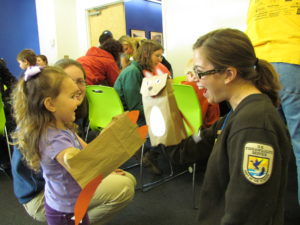
It takes staff to manage a refuge and help the public responsibly enjoy and learn about the wonders of the refuge. Salmon Camp on the Kodiak Refuge was one of the most successful programs serving more than a hundred families a year, many of them from the Coast Guard Base Kodiak. With the public use staff cut from four to one, Salmon Camp in Kodiak is no more.
These cuts will affect all public land users, and biological work that keeps our wildlife safe. Next, Congress and the Administration may question why we are holding on to these lands that are “unproductive” and unmanaged. And after that, Friends fear they may add oil and gas as a purpose for all refuges as they did during the first Trump term for the Arctic Refuge, sell off some refuges for development, permit mining, and allow “intensive management” (such as predator control) which is contrary to the refuges’ purpose of maintaining natural biodiversity. Even if refuge lands are not sold, there will be few refuge staff left to protect the original purposes of refuges. These are OUR refuge lands, park lands, and forests. The Administration has already announced plans to heavily log national forests and suspend provisions of the Endangered Species and Migratory Bird acts.
We need you to call your Congressional representatives. Every day. Ask that the staff fired under DOGE be rehired, the vacated positions be refilled, the refuge manager positions filled (only 7 managers for 16 refuges) and credit card use restored so they can buy supplies for the rapidly approaching field season (DOGE put a $1 limit on credit cards). Remind them that you value refuge employees and the work they do to protect wildlife and refuges. Refuges are not for sale! Many members of Congress are starting to complain that they are getting too many phone calls. Good. These elected officials work for US, and they should respond to us, their constituents, not the President. We cannot allow them to dismantle public lands.
Alaska’s two senators are Sen. Lisa Murkowski and Sen. Dan Sullivan. Our House member is Rep. Nick Begich. You can also reach them or any state’s delegation at the Capitol switchboard at 202-224-3121.
If we do nothing, and do not use our voices to speak up in protest, we predict that we will lose many of the public lands and the values they protect that make Alaska great.
The President’s Message
By Marilyn Sigman, President Friends of Alaska National Wildlife Refuges
There has never been a time like the present in my lifetime when National Wildlife Refuges—and their hard-working staff dedicated to carrying out the mission of the Refuge system—need friends who share the mission of stewardship of these lands and waters. Many of our members have spent part or all of their careers working in fields related to fish, wildlife, and habitat conservation. Others of you have joined Friends because you enjoy spending time outdoors hunting, fishing, hiking, birdwatching, and canoeing on refuges. You have responded to our calls in the past to speak out to our elected officials in support of good refuge policies and public land management actions. But now the entire system and its mission is under attack.
We are faced with an Administration that is likely to cut the federal budget more deeply than it has already been cut, which has already left Alaska’s refuges woefully understaffed to do the necessary research, conservation work, and outreach and education that promotes long-term stewardship. The Kodiak Refuge Visitor Center has already cut back with a seasonal closure and refuge outreach and education programs in Fairbanks have been canceled indefinitely. Oil and gas development is being targeted on all federal lands. Future layoffs could mean shuttering refuge facilities completely. Some refuges in Alaska are heavily visited, such as Kenai and Alaska Maritime, but others are used almost solely by subsistence users. Visitors would still be able to access refuges, but without any staff on site, we can anticipate increased poaching, garbage dumps, and other illegal uses of refuge lands.
What can we do? An immediate advocacy action you can take is to send in comments on the Izembek road draft Supplemental Environmental Impact Statement by this Thursday, February 13. Please click the link below to comment. Tell the Administration to choose the no-action alternative.
The Friends Board is committed to developing fund-raising strategies to greatly increase the amount of financial aid we can provide to refuges. If you would like to be involved in this effort, please contact a Board member.
I urge all of you to be friends to the Refuge staff who are feeling attacked by buyout demands and the removal of all references to climate change and the importance of diversity, equity and inclusiveness in the federal workforce as well as the participation of the diverse stakeholders in refuge management. Call, text, or send a thank you email to staff members you know or may have worked with as a Friends’ volunteer. We will also need more volunteers, so look for opportunities posted on the Friends website.
I urge all of you to be a friend to Alaska’s National Wildlife Refuges by writing and calling your Congressional representatives. For Alaskans, Senators Murkowski and Sullivan and Congressman Begich have the power to stop these impacts to OUR refuge lands as do the representatives of Friends’ members in other states. The Capitol switchboard is 202-224-3121.
I urge you to be persistent and relentless in speaking up about what is so valuable about the refuges and the mission of stewardship of these unique conservation lands.
| |
|
UPDATE (as of December 28th): A HUGE THANK YOU to everyone who attended the hearings, either in person or virtually! And an enormous shout out to those of you who have submitted comments.
The U.S. Fish and Wildlife Service has extended the deadline for comments until February 13th, 2025. Any comments already submitted will still be considered.
A proposed land exchange at the end of the Alaska Peninsula threatens wildlife conservation and the protection of public lands in Alaska. Pristine wilderness and high value wetlands within the refuge would be traded away in order to build a road from King Cove to Cold Bay. We need all Friends to speak up and oppose this land swap! Submit your public comment today- the deadline has been extended until February 13, 2025.
The draft Supplemental Environmental Impact Statement (draft SEIS) completed by the US Fish and Wildlife Service selected Alternative 6 as the preferred alternative- to implement a land swap with King Cove in order to build the road along the isthmus through the refuge and designated wilderness.
In person and virtual hearings:
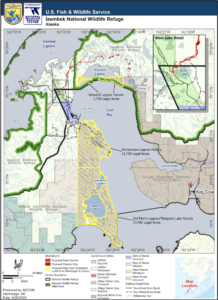
Map of the Preferred Alternative showing road corridor, exchange lands. Note how the road bifurcates the refuge at the narrowest part cutting between Izembek Lagoon and Kinzarof Lagoon. Also note the wetlands it will pass through and all the planned “material sites”. I imagine it will take a lot of gravel from those material sites to fill in a wetland like that. Note the significance of that narrow neck for migration. It is also a “blow hole” with winds howling from the Bering Sea to the north to the Gulf of Alaska to the south. Preventing drifting snow on this road would be a significant challenge.
Sample talking points for your comments:
The comments taken most seriously by agencies are those in your own words for your own reasons. But here are some thoughts on why the road is such a terrible idea.
Thank you, and remember to submit your comments by December 30, 2024 February 13, 2025!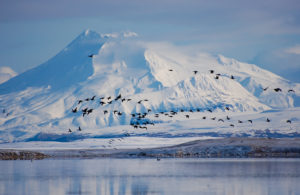
Black Brant, Izembek National Wildlife Refuge, PC: USFWS/Kristine Sowl
By Caroline Brouwer, Advocacy Committee Chair
Alaska’s refuges are taking a hit this month, between the decision by the Biden Administration to propose a land swap with the King Cove Corporation in order to build a road through the Izembek National Wildlife Refuge and the announcement that 400,000 acres of land in the Arctic National Wildlife Refuge will be auctioned off for oil and gas leases.
The only comforting news is that the announced acreage for oil and gas leasing in the Arctic Refuge is the smallest amount allowable by law. The Administration is required by law (the 2017 Tax Act) to hold a lease sale, so they have chosen to put the smallest acreage possible up for auction. This second Arctic Refuge lease sale will take place January 9, 2025. During the first lease sale in early 2021, there was very little interest from lease purchasers. We will see what happens in January.
The Izembek announcement (as part of the draft Supplemental Environmental Impact Statement) was just baffling in its absurdity. Refuge Friends and other public lands advocates have fought this potential road for decades, and now all of a sudden the Biden Administration decides to go forward with a road that will carve a path through one of the most remote and protected lands in the Refuge System, and for what? A supposed medical evacuation path in one of the most difficult terrains in the world to traverse in the winter. It’s nonsensical.
Friends sent out an action alert last week regarding the Izembek road, and a hearing was held in Anchorage on December 9th. Many, many thanks to those of you who attended! Please let us know if you went, and what your thoughts were on the hearing- you can email me here.
You can still comment online, at the remaining public meeting or at the virtual meetings this week. Each of the virtual meetings are tailored for an Alaska Peninsula community but they have been very clear that anyone can attend and testify at these virtual hearings.
A FWS web page.on the project has a great deal of background information.
Bethel, Thurs, Dec. 12, 6 – 8, Yupiit Piciryarait Cultural Center, 420 Chief Eddie Hoffman Hwy
Virtual – Register online at the links below
Please take action by December 30th! The link to comment is here.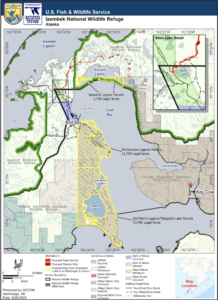 Map of the road the FWS proposes to allow in Alternative 6, the preferred alternative. Note the wetlands and the narrow neck of land between the two highly productive lagoons – Izembek and Kinzarof Lagoons – that will be bifurcated by the road. Note also the intent to take gravel from numerous sites along the road. Source: Draft SEIS
Map of the road the FWS proposes to allow in Alternative 6, the preferred alternative. Note the wetlands and the narrow neck of land between the two highly productive lagoons – Izembek and Kinzarof Lagoons – that will be bifurcated by the road. Note also the intent to take gravel from numerous sites along the road. Source: Draft SEIS
Today the U.S. Fish and Wildlife Service released their draft Supplemental Environmental Impact Statement for the Izembek National Wildlife Refuge, outlining a path to build a road through one of the most important wetland habitats in Alaska. This proposed road threatens not only migratory birds and sustainable Indigenous lifeways in this region, but it also lays out a path for the transfer of lands specifically protected by the Alaska National Interests Land Act (ANILCA) across Alaska for development.
“The proposal to build a road through the Izembek Refuge as outlined in the SEIS today is an extremely dangerous precedent for fish and wildlife habitat protection in Alaska,” says Marilyn Sigman, President of the Friends of Alaska NWRs. “The Izembek Refuge is wilderness, and species such as the Emperor goose and Pacific black brant depend on this place as their breeding habitat. A road bisecting the refuge puts the conservation of these lands at extreme risk.”
The lands proposed for exchange are not equivalent in conservation value. The land exchange as proposed would swap lands within the Refuge with lands currently owned by the King Cove Corporation. Dozens of native tribes and tribal entities, including the Native Village of Hooper Bay and its village corporation, have opposed this land exchange.
We have joined with many conservation and tribal partners to oppose the road across the Refuge throughout the Biden Administration and thus are extremely disappointed to see this land exchange to enable road-building come at the tail end of this Administration.
This week, October 13-19, 2024, we celebrate National Wildlife Refuge Week, a time to honor the special places that make up the National Wildlife Refuge System. Here in Alaska, we are home to 16 national wildlife refuges, vast and diverse lands that protect an incredible variety of wildlife. From migratory birds to bears and salmon, these refuges safeguard species that are crucial to Alaska’s ecosystems. They also give us beautiful spaces to explore and enjoy the outdoors.
But Alaska’s refuges are just part of a much larger system that stretches across the entire United States. Together, these lands form the largest network of public lands dedicated to wildlife conservation. Sadly, this system is in danger. Severe budget cuts have left many refuges understaffed and underfunded. Nationwide, the system has lost over 800 staff members since 2010, making it difficult to maintain habitats and protect wildlife.
Why Refuges Matter in Alaska and Across the Country
In Alaska, our 16 refuges are vital to protecting our state’s unique landscapes and wildlife. Whether you’ve visited the Kenai National Wildlife Refuge, hiked the stunning Arctic National Wildlife Refuge, or explored the vast wetlands of the Yukon Delta, you know how special these places are. They protect important habitats and give us a chance to experience nature up close.
But this problem goes beyond Alaska. Across the country, national wildlife refuges are facing similar challenges. Without enough staff and funding, many refuges are struggling to meet basic needs like habitat restoration, infrastructure upkeep, and visitor programs. This puts wildlife and the lands they depend on at risk.
How You Can Help
There are several ways you can support our refuges during National Wildlife Refuge Week:
Explore a Refuge: Get outside and visit one of Alaska’s refuges, or find a refuge near you. Spending time in these wild places is a great way to appreciate their beauty and learn more about their importance.
Raise Awareness: Help spread the word about National Wildlife Refuge Week by sharing posts on social media with #RefugeWeek. Let others know why these places matter and what they can do to help protect them.
Advocate for Change: One of the most powerful ways to make a difference is by contacting Congress. Let your representatives know that you care about national wildlife refuges and want them to support increased funding. It’s quick and easy to take action—just click here to get started.
Our national wildlife refuges, both in Alaska and across the country, are essential to protecting wildlife and preserving the natural beauty we love. By raising awareness and taking action, we can help ensure these special places remain protected for generations to come.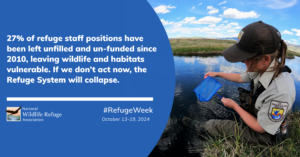
The mission of Friends is to support the 16 national wildlife refuges, which of course includes advocating for the wildlife that make these refuges their home. We are extremely concerned by the current predator control actions of the State of Alaska on state lands, which directly impacts adjacent federal lands and the animals that live on and migrate through wildlife refuges.
Last year, the Alaska Board of Game expanded a plan for predator control in game units adjacent to Togiak and Yukon Delta national wildlife refuges to include wolves and both brown and black bears. The Mulchatna Intensive Management Operational Plan was developed in response to a very real problem: the collapse of the Mulchatna caribou herd. It should be noted that the decline of the Mulchatna herd has continued despite the killing of over 450 wolves for predator control. Biologists are clear that the cause of the caribou population collapse is much more complex than the predator-prey dynamic and in fact, studies suggest a stronger link to forage quality and quantity resulting in lower pregnancy rates and higher caribou calf mortality. These issues are compounded by higher incidence of brucellosis, causing higher abortions and stillbirth rates. Despite these facts, an expanded predator control plan was implemented in 2023 with a plan to kill an estimated 15-20 brown bears.
Sadly, in just the first year of the plan, 94 brown bears, including several year-old cubs and 11 younger still-nursing cubs, were killed. This represents an estimated 74% of the brown bear population in the plan area, and significantly more than the planned take of 15-20 bears. In addition, five black bears and five wolves were killed. While the control program may not have taken place on the refuges proper, bears don’t know boundaries and roam widely so it’s very likely that bears of Togiak and possibly Yukon Delta refuges were killed during this 17-day killing spree.
In an opinion piece in the Anchorage Daily News on August `14, 2023, 34 retired Alaska wildlife managers and scientists including several of our members said they did not believe the Mulchatna predator control decision was underpinned by the best available science, nor was it adequately vetted with the public prior to implementation.
This expanded predator control plan is scheduled to continue through 2028. The wildlife of Alaska is its most precious resource and this indiscriminate killing can’t be allowed to continue.
We urgently ask our members who are Alaska residents to contact your state representatives and express your outrage
that the implementation of the Intensive Management plan for Caribou Units 9B, 17, 18, 19A and 19B has resulted in the deaths of nearly 4 times the projected number of bears in the plan and that the Board of Game should scale back the plan accordingly and:
that Legislators ensure new members better represent the diverse interests of Alaskans and wildlife as the current Board of Game (BOG) is heavily weighted to hunting and trapping interests (the Governor appoints and Legislators approve all BOG members).
You can read the profiles of the Board of Game members here. There are no working biologists on the Board of Game. The opportunity to remedy this situation could lie with the two members of the BOG whose terms are up this June. You can also express your concerns to Fish and Game Commissioner Douglas Vincent-Lang or ADFG Director of Wildlife Conservation Ryan Scott regarding the problems with this specific Intensive Management plan.
Fish and Wildlife Service Funding Passed and Proposed Rule: National Wildlife Refuge System; Biological Integrity, Diversity, and Environmental Health. Two big things regarding refuges have hit this week- news regarding federal funding for all refuges across the country, and our advocacy for a proposed rule change strengthening protections for biological integrity and diversity in the refuge system.
Five months into the fiscal year, Congress finally passed a budget for the Department of the Interior last Friday night, and it was signed into law by the President on Saturday. This bill was not, however, great news for refuges. Friends has lobbied for a significant budget increase for the Refuge System, for a near tripling of the current, ridiculously low budget that barely allows refuges to keep staff on the ground, never mind do the ground-breaking biological and scientific wildlife work the Refuge System is known for.
While funding for Alaska’s 16 refuges is still to be determined, we know that the National Wildlife Refuge System as a whole took a 14.5 million dollar cut, down about 2% from the previous year budget. This cut, combined with a 5.5% employee pay increase, stresses an already underfunded system of public lands. This dramatically underfunded system is at risk of being unable to accomplish its critical conservation mission.
Sitting at just above $500 million in annual funding, Congress expects these monies to cover 570 units of the Refuge System across 95 million acres of land and 750 million acres of ocean. 80 million of the land acres are in Alaska, yet staffing and project shortages mean there are so few biologists and pilots that on-refuge research and wildlife surveys frequently do not happen.
The U.S. Fish and Wildlife Service recently directed its staff to do a study of all refuge acres and come up with a realistic number for how much is actually needed to operate the Refuge System in a way that would maintain healthy lands and waters, robust wildlife populations, and recreational access for people. That number was $1.5 billion, triple the current funding.
Senator Lisa Murkowski is the Ranking Member on the Senate Appropriations Subcommittee for Interior lands. She has the ability to assert her desire to see Alaska’s refuge lands funded. Her Anchorage office is (907) 271-3735. Friends are sure that if enough people call her office and ask for increased funding for Alaska’s refuges, she will follow through.
Proposed Rule: National Wildlife Refuge System; Biological Integrity, Diversity, and Environmental Health
Friends of Alaska National Wildlife Refuges submitted comments in collaboration with other Alaska-based conservation groups in support of this proposed rule. We expressed our support for (1) policy updates to better protect wildlife species threatened by climate change, (2) a prohibition on predator control on refuges in Alaska and nationwide, and (3) a requirement for refuges to cooperate with and coordinate with tribal entities and local communities. You can read the entirety of our comments in the attached letter.